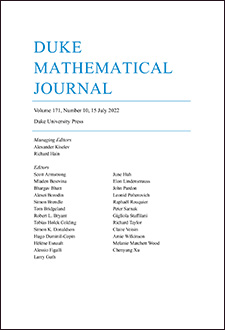Abstract
Let G be a connected reductive group over ℂ, and let $\mathfrak {g}$∨ be the Langlands dual Lie algebra. Crystals for $\mathfrak {g}$∨ are combinatorial objects that were introduced by M. Kashiwara (cf., e.g., [6]) as certain "combinatorial skeletons" of finite-dimensional representations of $\mathfrak {g}$∨. For every dominant weight λ of $\mathfrak {g}$∨ Kashiwara constructed a crystal B(λ) by considering the corresponding finite-dimensional representation of the quantum group Uq($\mathfrak {g}$∨) and then specializing it to q=0. Other (independent) constructions of B(λ) were given by G. Lusztig (cf. [9]) using the combinatorics of root systems and by P. Littelmann (cf. [7]) using the "Littelmann path model." It was also shown in [5] that the family of crystals B(λ) is unique if certain reasonable conditions are imposed (cf. Theorem 1.1).
The purpose of this paper is to give another (rather simple) construction of the crystals B(λ) using the geometry of the affine Grassmannian \mathscr {G}$G=G($\mathscr{K}$)/G($\mathscr{O}$) of the group G, where $\mathscr{K}$=ℂ((t)) is the field of Laurent power series and $\mathscr{O}$=ℂ[[t]] is the ring of Taylor series. We then check that the family B(λ) satisfies the conditions of the uniqueness theorem from [5], which shows that our crystals coincide with those constructed in the references above. It would be interesting to find these isomorphisms directly (cf., however, [10]).
Citation
Alexander Braverman. Dennis Gaitsgory. "Crystals via the affine Grassmannian." Duke Math. J. 107 (3) 561 - 575, 15 April 2001. https://doi.org/10.1215/S0012-7094-01-10736-9
Information





